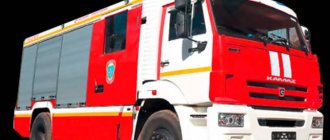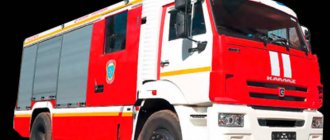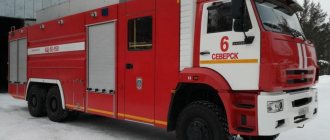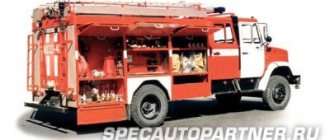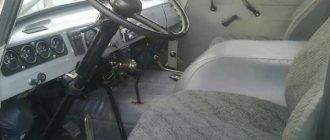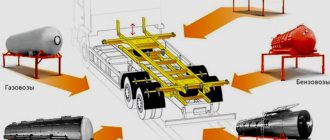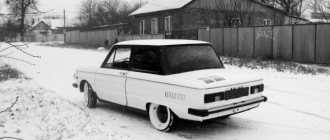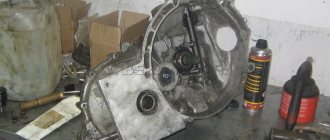Technical characteristics of the AC-40 (130)-63B firefighting machine:
| Basic chassis | ZIL-431412/4×2 (or equivalent) |
| Engine | carburetor |
| Power (maximum) | 150 hp |
| Speed (maximum), full load | 90 km/h |
| Number of seats for combat crew | 1 +6 people |
| Stock of fire extinguishing agents: | |
| water, no less | 2.36 cubic meters / 2360 l |
| foaming agent, no less | 0.17 cubic meters / 170 l |
| Suction device | pump (vacuum jet) |
| Length of pressure hoses | 348 m |
| Pump | NCP-40/100-R-R (centrifugal single-stage) |
| Pump delivery | 40 l/s |
| Pump head | 100 m |
| Number of hand barrels | 6 pcs. |
| Overall dimensions (length / width / height) | 7680 / 2500 / 2780 mm |
| Vehicle weight with full load | 9600 kg |
Looking for fire trucks?
Place a request and the sellers will call you!
Place a request
All information is taken from public sources
Please rate this article: Rated: 1, rating: 5 out of 5
Your opinion is very important to us
ATs-40(43101)-1IR - wiki-fire.org
Fuel economy indicators
A tank truck can be used as an independent combat unit with the intake of foam concentrate from a foam tank or an external reservoir and the intake of water from a tank, from a reservoir or from a water supply network.
The tank truck is designed for operation in areas with a temperate climate at ambient temperatures from minus 40 to plus 40°C.
| When operating from your own tanks | |
| Operating time, min: | |
| - one barrel B | 18.02 |
| - one barrel A or two barrels B | 9.01 |
| — one SVP-4 barrel | 8.68 |
| — one GPS-600 generator | 11.57 |
| Volume of the resulting foam solution: | 0.06 |
| — 4% | 4166.67 |
| — 6% | 4166.67 |
| Amount of foam, m3: | |
| -low multiplicity (K=10) | 41.67 |
| -medium magnification (K=100) | 416.67 |
| Possible area of extinguishing with foams, m2 | |
| low expansion rate at Itr = 0.1…0.15 l/(s*m2) | 69.44…46.3 |
| average expansion rate at Itr = 0.05…0.08 l/(s*m2) | 138.89…86.81 |
| Possible volume of extinguishing with medium expansion foam at Кз=3 (4- or 6% foam solution), m3 | 138.88…138.88 |
| When working with the installation on water sources: | |
| Maximum volume of PO solution, l: | |
| — 4% | 6250 |
| — 6% | 4166.67 |
| Operating time, min: | |
| — one SVP-4 barrel | 8.68 |
| — one GPS-600 generator | 11.57 |
| Amount of foam, m3: | |
| -low multiplicity (K=10) | 41.67 |
| -medium magnification (K=100) | 416.67 |
| Possible area of extinguishing with foams, m2 | |
| low expansion rate at Itr = 0.1…0.15 l/(s*m2) | 69.44…46.3 |
| average expansion rate at Itr = 0.05…0.08 l/(s*m2) | 138.89…86.81 |
| Possible volume of extinguishing with medium expansion foam at Кз=3 (4- or 6% foam solution), m3 | 208.33…138.88 |
wiki-fire.org
Fire trucks ZIL 130
Over the entire period of its existence, the PA on the 130th platform produced 10 modifications of vehicles. The most popular fire truck today is the ZIL 130 ATs-40-63B. In terms of performance characteristics, it is the optimal vehicle for going out on calls in an urban environment. The vehicle is used to deliver personnel, special equipment and additional equipment to extinguish fires. The advantage of these cars is a 2.4-ton water tank, as well as an additional 170-liter foam concentrate tank.
The AC-40-63B cabin has two rows of seats for personnel of 6 people. For the efficiency of fighters, four doors are provided. The driver's seat is adjustable according to the height and weight of the rider. The seats for passengers are stationary; underneath there are boxes for tools and personal equipment.
To save space, compartments for hoses were installed on the roof of the cabin. The sleeves in the basic set are 348 meters long. Special equipment and supplies are stored in the side compartments of the body.
Two types of pumps are installed on the AC-40 PA:
- single-level centrifugal PN-40UA rear position;
- single-stage normal pressure NTsPN-40/100.
They are located in the rear of the car. In addition to the pump, the fire installation includes a manifold, a foam mixer and pressure valves. For operation at night, the tanker is equipped with a lighting and alarm system.
The advantage of this model is a gasoline eight-cylinder four-stroke engine with a liquid cooling system. Fuel consumption per 100 km is 41.5 liters. When fully loaded, the car reaches a speed of 80 km/h. To strengthen the structure of the machine, it was placed on a spar frame made of low-alloy steel 30T. The front part was reinforced with braces, and above the rear axle beam the spars were equipped with reinforcing inserts.
The suspension is dependent, on springs and telescopic shock absorbers. Gable wheels were installed at the rear. This gave the car additional stability and off-road capability, which is important when going on call in rural areas. In the latest modifications, the AC-40 received arched tires on the drive axle and a winch on the bumper. Overall dimensions of the machine (l*w*h) – 7680*2500*2780 mm. Weight when fully equipped – 9600 kg.
The basic package includes equipment for the combat crew, breathing apparatus, HBP with connecting fittings, pressure hoses DN51, 66, 77. Portable monitor barrel, manual combined, overlap and air-foam barrels. Water collector, hydraulic elevator, keys, connecting heads. Foam generator GPS-600. Powder fire extinguishers.
Performance characteristics of the AC-40-63B vehicle
| Pump | PN-40UA |
| Productivity, l/sec | 40 |
| Pressure at nominal speed, m | 100 |
| Suction pump | Gas jet |
| Suction height, max, m | 7.5 |
| Time to fill the suction line at max geometric suction height, sec. | 40 |
| Foam mixer | PS-5 |
| Foam mixer type | Water jet ejector |
| Foam mixer capacity at low expansion rate, m3 | 25 |
| Foam mixer productivity at average expansion rate, m3 | 250 |
| Extinguishing area with low expansion foams at Itr = 0.1…0.15 l/(s*m2) | 42…28 |
| Extinguishing area with low expansion foams at Itr = 0.05...0.08 l/(s*m2) | 83 |
Tank truck AC-40 | Model blog
- Posted by sergey
- Date: April 21, 2015 at 17:25
Another area, in addition to the military, is the use of the ZIL-131 chassis as a base for various fire fighting equipment.
One of the most common types of such vehicles was the fire tanker ATs-40(131). It is designed to transport a combat crew of 7 people, firefighting equipment, water and foam concentrate. With the help of AC-40(131), a fire is extinguished with water from its own tank, water supply system or open reservoir. It is possible to use your own or an external foam concentrate tank. The machine was developed in 1968. and in the same year a prototype was manufactured at the Priluki plant. After successful tests, in 1970. the car was put into production. During operation, a number of shortcomings were identified. In particular, insufficient rigidity of the superstructure, poor fastening of the breakwaters inside the water tank, poor fastening of the tank to the frame, which led to its deformation and leakage. The design of the machine is a 2100 liter water tank. with two cabinets on the sides, a pump and a 150-liter foam concentrate tank were installed in the rear. The pump was driven through a power take-off, which can be used both when parked and when driving in 1st or 2nd gear. During long-term operation at a standstill, additional cooling of the pump is provided. To prevent water from freezing at low temperatures, the water tank is covered with thermal insulation material and equipped with an electric heating system. A fire monitor was mounted on the roof of the cabin, which was controlled from the cabin through the hatch. To supply foam, it is possible to replace the water barrel with a special one.
In 1983 a modernized version of the ATs-40(131) fire engine, model 137A, was released, in which they tried to eliminate these shortcomings; it went into production in 1984. During the modernization, the tank capacity was increased by 100 liters, and the fire monitor could now be controlled directly from the crew cabin. During production, changes were periodically made to the appearance of the superstructure.
Photos of the fire tanker AC-40(131) were taken by me on June 25, 2014 at the AvtoVAZ Technical Museum in Tolyatti. Here, presumably, a car made after 1990 is presented. release, since it has a rear wall of the superstructure without bending, but I can’t say for sure. In addition to taking photographs, I took measurements of the fire truck and I think, over time, to draw a drawing of it. There is also an idea: to make a model of the AC-40(131) tank truck yourself, using your own photos and measurements, since the model from ZZ models does not quite suit me.
Category: Walkaround
hobby-models.ru
Engine
| Engine model | ZIL-508.10 |
| engine's type | carburetor |
| Number and arrangement of cylinders | V8 |
| Working volume, l | 6,0 |
| Compression ratio | 7,1 |
| Power, hp (kW) | 150 (110) at 3200 min.-1 |
| Torque, kgf m (Nm) | 41 (402) at 1800-2000 min.-1 |
Story
AC-40(130) model 63B is a modernized version of the AC-30(130) model 63A tank truck. Documentation for it was developed in 1977, and in the second half of 1978, serial production began with the release of an installation batch of 20 machines. Until 1982, both models (-63A and -63B) were produced in parallel. Moreover, the approved annual production plan for the AC-40(130)-63B was constantly being disrupted all this time, and the plant compensated for the “under-produced” vehicles by exceeding the plan for the old modification of the AC-30(130)-63A. Only by 1983 was the production of -63B able to stabilize. Then, over the course of several years, production growth only increased, reaching about 2,000 units per year in the second half of the 1980s. AC-40(130)-63B received a new enlarged tank with a volume of 2350 liters, instead of 2100 liters. model 63A, and an enlarged foam tank with a capacity of 170 liters. instead of 150 l. at -63A. As a result of these changes, the superstructure (body) became noticeably wider, which is why they abandoned the decorative trims on the wheel arches that were previously installed on the 63A model. Another noticeable difference between the -63B and -63A models was the pressure pipes. Now they have been removed inside the superstructure and closed with hatches. During the production of the AC-40(130)-63B, changes were made to the appearance of the superstructure to simplify its production. Cars manufactured 1978-1982. had a so-called “low skirt”, which formed a wheel arch, which was later abandoned. Since 1990, the back wall has become straight, without bending. Since the late 1980s, machines without a window in the pump compartment door have been periodically produced.
There were also changes to the chassis. So, since February 1984, the ZIL plant switched to producing the ZIL-130 chassis with the so-called “Kamaz” braking system. But what was good for a regular truck became a big problem for a fire truck. Now, before each departure, we had to wait until the air needed to operate the braking system was pumped in. This took several minutes, which increased the time it took to respond to an alarm... Since 1986, in accordance with OST 37.001-269-83, the chassis of the ZIL-130 vehicle has received a new index ZIL-431412. But this did not affect the index of the fire tank - until the second half of the 1990s, it was produced under the previous name ATs-40(130)-63B. In September 1992, the ZIL plant stopped producing the ZIL-431412 chassis. In this regard, -63B produced in the mid-1990s were based on the UAMZ-ZIL-431412 chassis produced by the Ural Automotive Plant. A characteristic feature of these vehicles was the ZIL-131 cab on the ZIL-130 chassis.
I would like to add on my own behalf that ZIL is now produced in Mexico.
AC-40 (ZIL 130) AIST. Destroyer of traditions.: diecast_43
The first industrial implementation of this Hi-Tech-Ketai model took place, it’s scary to think - in the fall of 2014! After all, 1000 years ago! The model was released by the Kostroma premium division - SSM. (You can read it in detail in the Commander’s post, dated September 23, 2014.) At that time, no one questioned that there was no need to expect “complex” add-ons in the budget AIST. And now it is complex, and made at the same level (cons: windshield wiper logs, blister, plastic (matte!) frame...although what is considered a minus / plus here?), and at an affordable price. I have never been carried away (except for fire trucks Chernobyl Nuclear Power Plant) with a fire theme, and I don’t deeply understand the intricacies of the design of the “01” car, but I couldn’t resist this “fire.” No way.
This view completely knocked my toad out. In one fell swoop :))
I can’t compare it with the SSM product, I twirled it in my hands in the store, read the posts, and toad...toad... I licked my lips then - and took my traditional position “Zhdun - Rogue.” There was no hope at all that the AC-40 would be one on one with the SSM model. The superstructure is really complex, it’s not some kind of “cube booth”... From the photo, there are differences from the SSM product. Are they significant? Did such ATs-40 survive until the times of St. Petersburg and the Ministry of Emergency Situations? Probably yes, although I don't care at all.
General form. “50 shades of red”...well, let’s say in the “warm red segment”.
A normal “Old AIST” chassis, not a “chocolate bar a la Zhurnalka”.
Interior painted. It’s the interior, not just the seats.
The fighting compartment is highlighted (even with a handrail).
The tidy is clear. The interior color - a kind of “fire engine interior” - is very true.
The rear view is what captivated me. Everything is excellent, graceful drapes, behind the glass there is a picture, not emptiness (as on the ATs-30 AIST), KamAZ lighting equipment, this time, is made to 4+, and is unlikely to require replacement.
I have already 2 pieces. ATs-30 AIST (Currently “being converted”). The model was released in the spring of 2016, had (apart from the simplified bottom) two noticeable problems in coloring - more about it in the Commander’s post. On the AC-40 there is no trace of these problems, there are a couple more pluses for the model.
AC-30 it is clearly visible that the tone of the grille differs from the color of the model itself. This is not the case in the AC-40. Everything is monotonous.
The AC-30 template used to paint the front doors is narrow; the door seems elongated in length and narrowed in width. Everything is hit and miss here, one annoying thing is that the paint layer is too thick (which is generally typical for Kostroma products), and it grows in thickness towards the bottom of the body. The jointing is filled. It's a pity, because... in AVD sets (not painted) - the jointing is excellent, and with delicate coloring - it plays simply gorgeous.
The assault is complete! (quibbling: she would have the obligatory Inventory number and unit number, well, these are my extreme wishes. More than one unit comes to a major fire, and go after, figure out whose attack is where.)
View from above. Neither give nor take. Ales-normales.
View from below. I like the AIST better than the SSM, yes, the frame is plastic, but it doesn’t shine like an Easter egg.
Upcoming improvements/alterations (light up only): - replacement of wipers, front indicators. - installation of foglights, whitewalls, Piterskih GNZ. I consider it complete nonsense.
ps This model seemed to me like something breakthrough for the direction of AIST and its collectors. Will there be more complex (the same ladder on the 131st chassis) SSM models in a budget version? Wait and see. But the recent sales of stairs give me an idea...
diecast-43.livejournal.com
Online auction Antiquity
Online auction Antiquity
All from the ruble!
- Main section
How the auction works
Why register?How to buy?How to sell?Frequently asked questionsCart
Sell
RegistrationRecent
- Lots
SectionsSearchFavorites
- Lots
SectionsSearches
- Recent
- Lots
- Sections
- Search
Favorites
LotsSectionsSearchingBuying
- Home page
Featured Lots
Bargaining now I bought Didn't buy Subscribe to new lots Requests for lots from sellers Sellers' offers Selling
- Sell
On sale
TransactionsCompleted tradesTop up your accountDemandSeller settingsMy store [more details]ActivationSettings
- I'm buying
Featured Lots
Trading nowI boughtSubscribe to new lotsRequest lots from sellersSellers' offersSellingSellOn saleTransactionsCompleted auctionsTop up your accountDemandSeller settings
| Welcome to the online auction Antiquity Use the topic sections on the left, the search bar at the top, or the tags on the right to search for items. Want to know more?
Recommended lots: (show all) 3500 RUR Lenin January 21, 1924 Album of wreaths 80 RUR F409. ICONS. HELICOPTER. MI-10. MILES.. GVF. CIVIL AVIATION. TRANSPORT. EMBLEM. 350 RUR Libya 1980-82 battle scenes 11 couplings 3000 RUR A. AND P. BARTO » THE GIRL IS A GIRL » EDITION. LATGOSIZDAT RIGA 1948 900 RUR Japan - efficiency mi# 4524 - 4533 - 2008 (20) - 50 years of diplomatic relations between Japan and Indonesia 35300 RUR 25 RUBLES 2013 20 YEARS OF THE ADOPTION OF THE CONSTITUTION OF RUSSIA CONSTITUTION OF THE RF SILVER RUSSIAN FEDERATION 499 RUR # Turks and Caicos 1990**mi.900-09 Birds, mnh [21;107] 35 RUR USSR badge, Almaty, needle RUR 249 1969KM 3812 LENIN IN YOUR YOUTH 100 ANNIVERSARY OF THE BIRTH FIRST YOUTH PHIL EXHIBITION PC SG Kyiv 50 RUR Postcard St. Petersburg. Picart. Etching. Ships. 1981. (12280o) 400 RUR Antique porcelain plate Dish. faience - royal porcelain - KUZNETSOV - 15 25 RUR KhMK with OM USSR. 1990 SHALYAPIN F.I. | |
| 100.00 rub. | 34 seconds |
| 1000.00 rub. | 35 seconds |
| 2500.00 rub. | 36 seconds |
| 1650.00 rub. | 43 seconds |
| 50.00 rub. | 46 seconds |
| Entrance: | |
| • Open your own store | |
| • Affiliate program |
| Frequently asked questions and support |
| Terms of Use | Sell | Registration | Open your auction | Affiliate program | Profile | Help All rights reserved 1999 - 2022. Old man |
Engine
The car engine is a four-stroke, liquid-cooled, gasoline, carburetor, eight-cylinder, V-shaped, model ZIL-130 or ZIL-508.10, with a rated power of 110 kW – installed in front of the cabin under a metal tail with an alligator-type hood. To supply air to the engine, an air channel is equipped in the hood, which is connected by a corrugated pipe to an air filter VM-16 or VM-21 of the inertia-oil type (with an oil bath and oil-wet filter elements), which has an air intake pipe to the brake system compressor.
Heating system
Fire trucks, depending on their design, can be equipped with various additional heating systems for the crew cabin, tank capacity and pump compartment.
Most fire tankers in service have a modified exhaust system. Thus, exhaust gases from fire truck engines are used in the water intake system of the fire pump and for heating tanks, crew cabins, and the pump compartment.
Heating system for the cabin and pump compartment of the tank truck AC-3.0-40 (43206) 1MI
Exhaust system of fire tanker ATs-40 (431410) 63B
1 – engine; 2 – intake pipes; 3 – tank; 4 – gas-jet vacuum apparatus; 5 – spacer; 6, 7 – flange connection; 8 – muffler; 9 – exhaust pipes; 10 – heater (battery); 11 – fire pump
For this purpose, a gas-jet vacuum apparatus 4 is installed in front of the muffler 8, to which exhaust gases from the engine flow through exhaust pipes 2. Having passed the distribution chamber of the gas-jet vacuum apparatus, the flow of exhaust gases through spacer 5 can follow in two directions (depending on the period of operation of the fire truck - summer or winter). Switching of paths is carried out using an adjustable steel plug insert.
During the winter period of operation, the plug insert from flange connection 7 is moved to flange connection 6. In this case, exhaust gases from the muffler through spacer 5 enter a pipe passing under the bottom of the tank and then through heater (battery) 10 into the atmosphere. The battery, which is a finned cylinder cast from an aluminum alloy, is attached to the car frame under the pump. The exhaust gases passing through the battery give off heat to the pump compartment. On the pipe running under the tank on some models of fire trucks, a tank heater can be installed, which is a pipe surrounded along the length by a casing to concentrate heat. For the period of summer operation, the plug insert must be removed from flange connection 6 and installed in flange 7.
In fire trucks of other models with heating of the pump compartment by exhaust gases, the principle of the exhaust system is preserved, although depending on the purpose and the features of the body layout, the design may differ.
Currently, fire trucks are often equipped with autonomous systems based on serial heating and ventilation units, designed to ensure the required temperature conditions in the crew cabin and in the pump compartment.
On this topic ▼
Gas jet vacuum apparatus
Design and disassembly procedure
Thus, on the fire tanker ATs-3.0-40 (43206) 1MI, in the compartment under the crew cabin on the right side, an OV-65 heating and ventilation unit and an autonomous fuel tank for diesel fuel are mounted on supports. Fuel is supplied from the fuel tank to the heating and ventilation unit through a fuel line, which has a built-in solenoid valve that provides remote opening and closing of the fuel line with a built-in electric fuel heating device. Electric fuel heating is turned on only during the startup period of the heating and ventilation unit (while holding the “START” button on the control panel).
The air heated in the heating and ventilation unit passes through the air ducts into the calculation cabin and into the pump compartment. The right subframe support pipe is used as an air duct that supplies air to the pump compartment. The products of fuel combustion are discharged into the atmosphere through the gas guide pipe of the heating and ventilation unit and the outlet.
Conclusion. To ensure reliable operation of tankers and pump-hose vehicles, an additional cooling system is provided, and depending on the design, they can be equipped with various additional heating systems for the calculation cabin, tank capacity and pump compartment.
Links
- [wiki-fire.org/%D0%90%D0%A6_40_131_137%D0%90.ashx ATs-40(131) model 137 (-137A) ]
| : Incorrect or missing image | This article lacks links to sources of information. Information must be verifiable, otherwise it may be questioned and deleted. You may edit this article to include links to authoritative sources. This mark was set on November 23, 2014 . |
K:Wikipedia:Articles without sources (type: not specified)
Autoladder AL30(131)L21
One of the most common ZIL-131 firefighting vehicles was the ladder truck. The rotating base of the ladder was installed above the rear chassis bogie. The stability of the vehicle was ensured by four outriggers at the corners of the platform. The drive for turning and extending the stairs was carried out from the power take-off. The ladder was controlled by levers on a remote control located together with the operator's seat on a rotating base. On the opposite side, a spare wheel was attached to the base.
The AL30(131)L21 machine was produced in the city of Torzhok from 1968 to 1983. Production continued later, but under the designation AL30(131)506. The main difference was the lengthening of the ladder knees by 300 mm. Cars produced before 1983 had a control panel with three levers; after modernization, there were four levers.
The maximum reach of the ladder up to 30 meters allows extinguishing in nine-story buildings. Its sections are equipped with three multidirectional illumination spotlights. When folded, it can be used as a crane boom. The vehicle was equipped with additional assault ladders.
ZIL-131
- Car make: ZIL
- Country of origin: USSR
- Year of manufacture: 1966
- Body type: Truck
The legendary truck with a military spring - ZIL-131. The history of the car that brought to life the task of the heads of the USSR, which continues to serve in various fields to this day. The technical characteristics in the tables and the description of the operating qualities make it possible to understand why the machine has such a valuable reputation. The entire ZIL model range.
